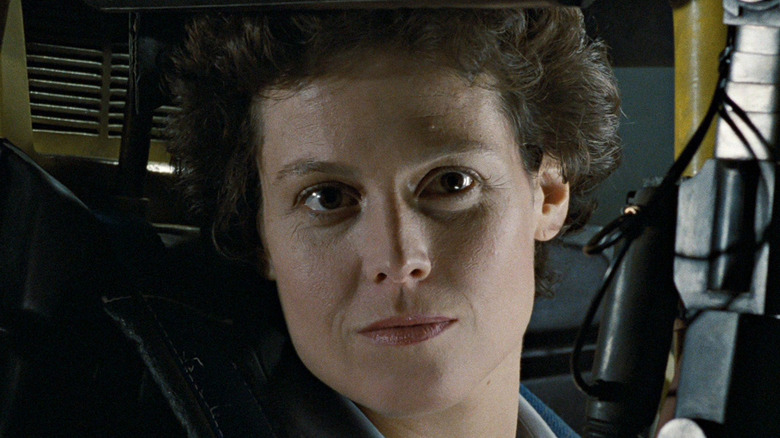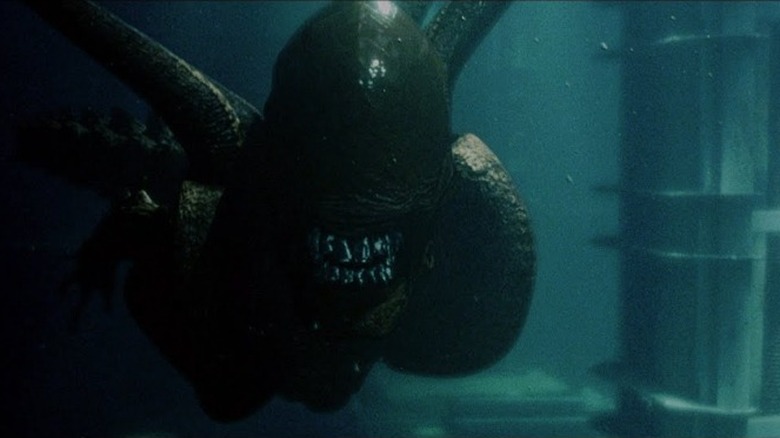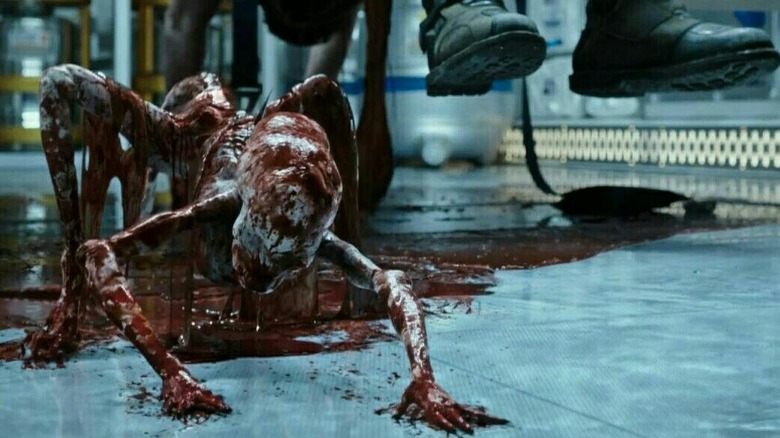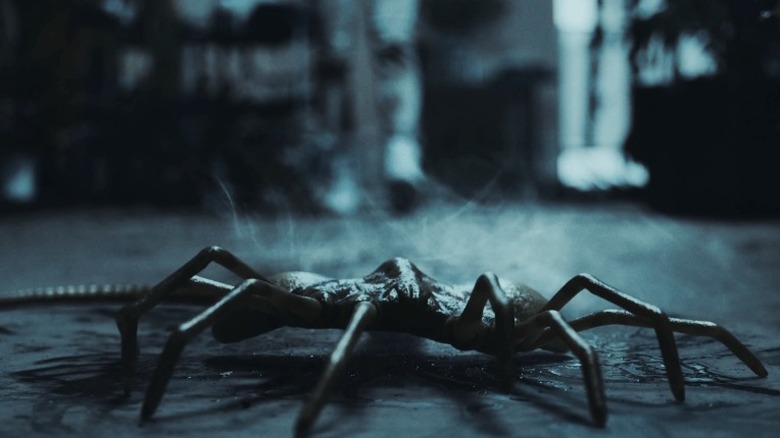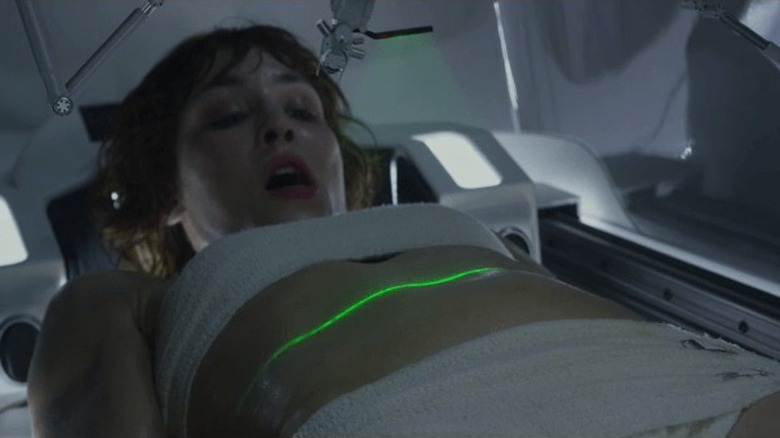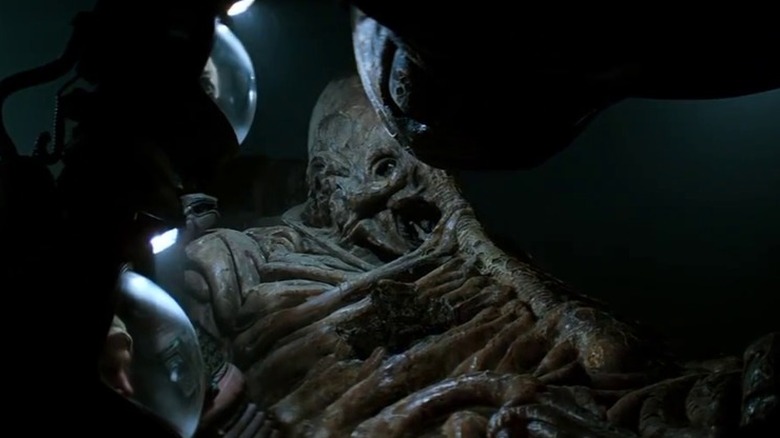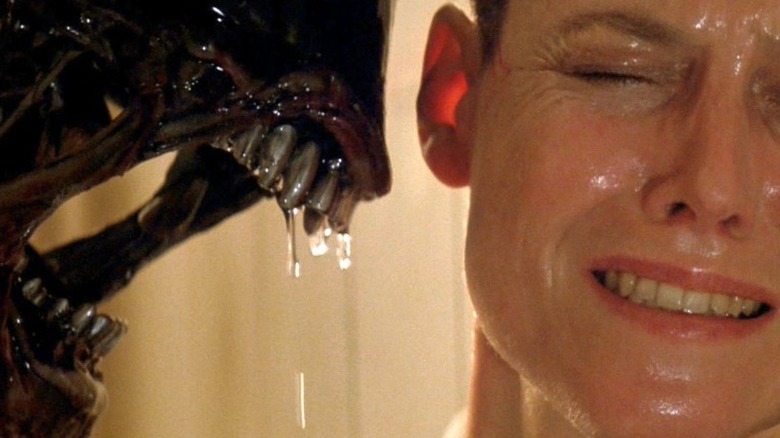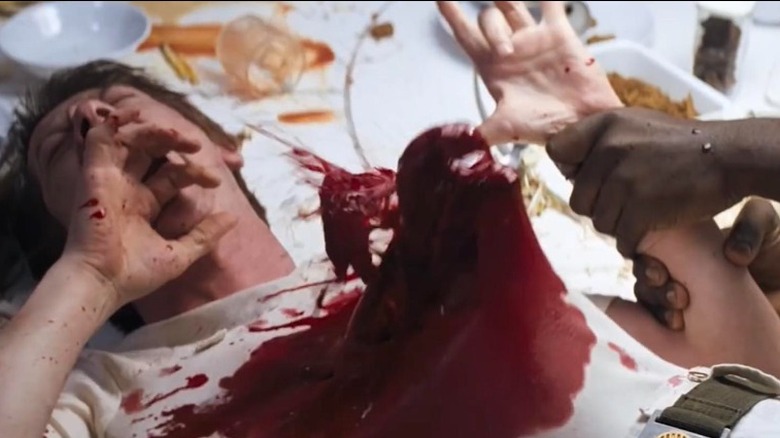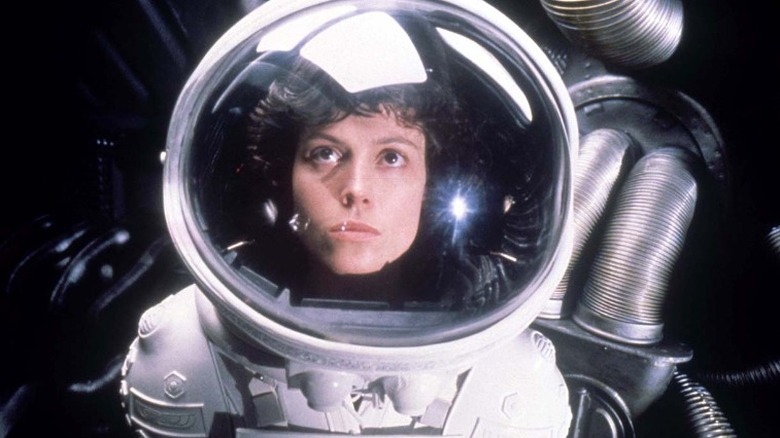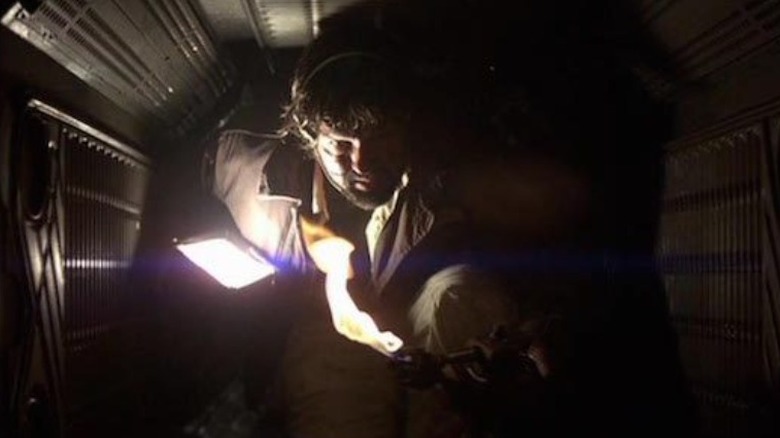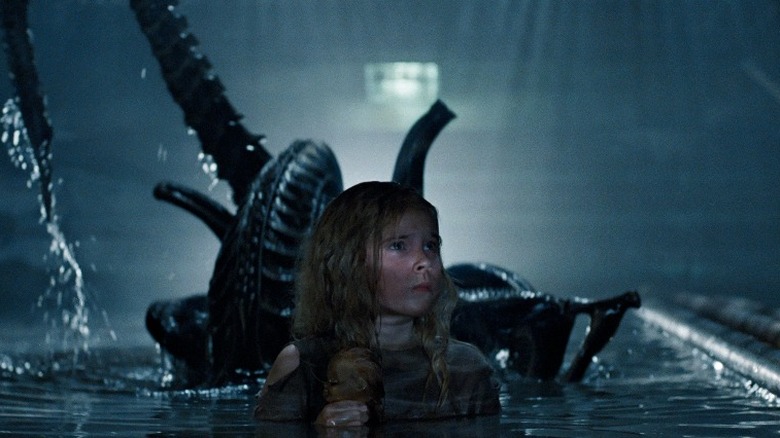The 10 Scariest Scenes From The Alien Franchise
Ridley Scott's "Alien" is a profound, seminal piece of science fiction and horror. In space, no one can truly hear you scream (per the first movie's official tagline), though just because it's unheard, it doesn't mean it's not there. With a profound scope, unmatched awe, gorgeous visuals, and bonafide body horror, the series is operatic, high-concept horror — basically, a haunted house series set in space. With talented directors at the helm, the Alien series offers visions of a horrific future that are as diverse as they are terrifying, which makes the wait for any semblance of another mainline entry all the more difficult.
Here, I review the 10 scariest scenes in the entire Alien franchise (including, yes, "Prometheus"). The scares extend far beyond the blackness of night into the infinite vastness of space, and while reducing a series known for gooey, Geiger-esque terror to just 10 scenes is difficult, the following sequences are simply the best in franchise with more scares than most. If you want to watch along, here is where you can find each of these movies online. Just beware: spoilers follow.
10. The underwater chase — Alien Resurrection
Jean-Pierre Jeunet's "Alien Resurrection" is arguably the weakest entry in the series, a grab bag of conventional shocks that's unfortunately tethered to the distinct (and dated) scare tactics of the late '90s. From its writer (none other than Joss Whedon himself) to its stars (Winona Ryder and Ron Perlman, in addition to franchise stalwart Sigourney Weaver), the entire enterprise feels immutably linked to the decade of its release.
Still, for all the hyper-masculine one-liners and arbitrary pick-up basketball games, "Alien Resurrection" still cultivates a genuinely tense atmosphere, with scares that shine brighter than the most magnificent supernovas. Chief among them is a mid-movie underwater chase sequence. As Ripley 8 (she's been cloned following her death in "Alien 3") and the remaining survivors of the Betty attempt to flee from the Xenomorph, they're forced to take a plunge into a flooded kitchen. One by one, they lower themselves into the water, take deep breaths, and swim. Soon enough, though, two alien pursuers arrive, moving through the water with fluid, almost dolphin-like, swiftness. It's an unconventional set-piece, and one the franchise should have made more use of. More aquatic aliens, please.
9. The backburster — Alien: Covenant
Ridley Scott's long-anticipated, ostensible "return to form" following his divisive "Prometheus," the quasi-prequel that posed considerably more questions than the franchise needed, is a curious beast. "Alien: Covenant," perched between the heady profundity of "Prometheus" and the sheer terror of Scott's original, proved just as divisive as its predecessor. Some praised the return of the iconic Xenomorph. Others lamented Scott's tenuous grasp on logic and consistency.
If nothing else (though there is a lot else, including a fabulous dual role for Michael Fassbender), "Alien: Covenant" is the closest the series has gone toward its horror roots since the first installment, especially a fervent, intense mid-movie setpiece. After responding to a mysterious radio signal containing a John Denver song, the Covenant crew lands on an ostensibly perfect planet. There, they track down the transmission's source and find a crashed alien ship. Meanwhile, Ledward (Benjamin Ridley) and Hallett (Nathaniel Dean) rush back to the pod after they're infected by an alien spore.
As Karine (Carmen Ejogo) endeavors to help, a neomorph (baby alien) bursts from Ledward's back. Maggie (Amy Seimetz) locks them both away, trapping Karine with Ledward's ooey-gooey corpse and a primal baby alien. The violence is off-the-charts and the tension palpable, augmented by a frenetic piece from Jed Kurzel's propulsive soundtrack. It's the best scene in "Alien: Covenant," and is enough to make "Covenant" a trip worth taking.
8. Facehuggers in the medbay — Aliens
Paul Reiser, you handsome, glorious trickster. Granted, he might as well have been wearing an "I'm a Bad Guy" sign for the entirety of James Cameron's action-oriented follow-up to "Alien," but it's still a shocking and terrifying scene when, desperate to leave LV-426 with Xenomorph DNA, he traps both Ripley and Newt (Carrie Henn) in the med-bay with not one, but two facehuggers.
Facehuggers, of course, are an early developmental stage of the Xenomorph, a parasitoid creature that wraps itself around the face of its prey, shoves its reproductive organs down their throats, and implants a chestburster before promptly dying. The facehugger is terrifying on its own, tapping into primal fears about consent, pregnancy, and bodily autonomy — it renders any victim a host for an alien creature — yet the way Cameron frames the slowly-mounting tension makes this scene its best appearance in the long-running franchise.
It's a terrifying slow-burn, punctuated by two strong jolts, frenetic action, and last-minute escapes — you can see its influence on Spielberg's own "raptors in the kitchen" sequence in "Jurassic Park." "Aliens" is considerably heavier on action than Scott's original, but here, Cameron proves he's capable of delivering truly bone-chilling scares.
7. The C-section — Prometheus
The Alien franchise, at times, feels like it's all about topping the chestburster scene from the first (don't worry, we'll get to that later). As such, every entry at one point or another indulges in some gory body horror. "Prometheus," Ridley Scott's long-awaited return to the series, is no different. Thematically and stylistically distinct from other Alien movies, "Prometheus," written by Jon Spaihts and "Watchmen" and "Lost" scribe Damon Lindelof, is less horror and more heady sci-fi space opera, with the likes of Noomi Rapace, Charlize Theron, and Idris Elba navigating dense, otherworldly politics (without helmets).
Still, "Prometheus" is keen on horror when it counts most, and boy, does it count here. As Rapace told The Irish Independent, "I was out there filming for about six months and it was super-intense, my body was in so much pain sometimes but it was absolutely amazing."
The most intense scene occurs midway through. Shaw, after sex with her infected boyfriend, discovers she is in an advanced stage of pregnancy after a medical scan. Though infertile, Shaw rushes herself to a robotic surgery table, and in full, graphic detail, undergoes a cesarean section, during which a squid-like alien creature is removed from her chest. It's a gut-wrenching and painful scene, and Rapace sells the terror of accelerated space pregnancy well.
6. LV-426 — Alien
LV-426 would be further explored in James Cameron's follow-up, "Aliens," but the original voyage to the planet remains one of the series' most haunting scenes. The crew of the commercial vessel, the Nostromo, is traveling to Earth. Mid-trip, they are awakened by Mother, the ship's computer, alerting them to a transmission from a nearby moon. Company policy mandates that distress signals be investigated, so the Nostromo lands. Dallas (Tom Skerritt), Kane (John Hurt), and Lambert (Veronica Cartwright) disembark on the strange, alien planet while the remaining crew– including Weaver's Ripley — remain on board.
The signal is coming from a derelict alien ship, and the ground crew enters, losing contact with the Nostromo just as Ripley deciphers the transmission — it isn't a distress signal, it's a warning. The planet itself is stark, though rich in atmosphere, augmented by its scale and ambiguity. H.R. Giger designed the planet and the ship itself, working from Scott's brief note that it look "inhuman." The design is terrifying, modeled from plasticine and polystyrene over a metal frame, and remains one of the series' most iconic images. Three astronauts in awe of a Brobdingnag-esque, derelict spacecraft. It doesn't get more terrifying than that.
5. A familiar friend appears — Alien 3
"Alien 3" is the black sheep of the "Alien" franchise. Part of that is linked to the movie's decision to unceremoniously kill off almost every survivor of "Aliens," including Newt, before the movie even begins. The rest is linked to just how incongruous the movie feels both in the series and, frankly, within itself. "Alien 3" is like four different movies in one, with the machoism of Cameron's "Aliens" merging poorly with the more restrained tension of Scott's original. Director David Fincher has infamously disowned the movie. "I'd always had this naïve idea that everybody wants to make movies as good as they can be, which is stupid," he told The Guardian in 2009. "I learned on ['Alien 3'] that nobody really knows, so therefore no one has to care, so it's always going to be your fault."
Still, in recent years, even the rough theatrical cut has been reconsidered, with Peter Suderman of Vox remarking, "Director David Fincher famously disowned his own entry in the Alien franchise — but it's actually a showcase for his creative vision." That creative vision is in full swing when the Xenomorph on the prison planet ambushes Ellen Ripley and several others in the infirmary. The alien quickly dispatches the others and slowly crabs toward Ripley as she crawls away on the floor. It looks at her and moves in closer as she recoils. Then, it slowly backs away and leaves. It's a terrifying confrontation, rendered more poignant and frightening on account of Ripley's history with the creature.
4. The chestburster scene — Alien
Kane's death in the original "Alien" is arguably the most famous scene in the entire franchise. It's an enduringly popular, oft-emulated scare. Even series stars were unaware of what was going to happen, with the crew concealing how much animal blood and guts were going to be used to ensure an authentic reaction from the cast. Veronica Cartwright's screams are genuine. John Hurt's performance is visceral. Its legacy is undeniable. It's one of cinema's most terrifying, shocking sequences, known even among those who haven't seen the movie. It has terrified entire generations of moviegoers and will remain a perennial fixture of cinematic history.
Yet, for as profound as the scene is, its infamy has, in some capacity, reduced its ability to shock. It's a strange argument to make because the scene is perfect. The scare is infamous. Yet, as with the first of anything, the opportunity remains for it to be surpassed. While the chestburster is the most famous sequence in the entire franchise, in terms of pure, unadulterated terror, it isn't quite the scariest.
3. A stowaway — Alien
In terms of haunting Gothicism, the concluding moments of "Alien" are more terrifying than the infamous chestburster scene, in part because of the chestburster itself. With the stakes and parameters set — chiefly, nothing is off limits, so everything goes — "Alien" ambles through its unpredictability masterfully.
Ellen Ripley has successfully detonated the Nostromo and escaped alongside the orange tabby cat, Jonesy. She is the sole survivor. She prepares for stasis while simultaneously making her last broadcast, an elegiac reflection on the preceding events. "Final report of the commercial starship Nostromo, third officer reporting. The other members of the crew — Kane, Lambert, Parker, Brett, Ash, and Captain Dallas — are dead. Cargo and ship destroyed. I should reach the frontier in about six weeks. With a little luck, the network will pick me up. This is Ripley, last survivor of the Nostromo, signing off."
As Ripley prepares, director Ridley Scott unleashes one last scare. The Xenomorph, having camouflaged itself in the black, rubber tubing of the escape pod, awakens. Its hand moves, startling Ripley. It's enough to catapult audiences from their seats. Thoroughly tense, Ripley must then dress and prepare for one final battle as the Xenomorph, gloriously designed, unfurls itself and slowly makes its way toward her. The killer is never dead, and one of the most terrifying moments in "Alien" is a frightening confirmation of this trope.
2. Monsters in the vent — Alien
Jump scares get a bad rap. To the undiscerning viewer, they lack artistry and intent. There is some truth to this argument. When deployed poorly, they're cheap, ephemeral scares, especially when used in lieu of genuine tension or atmosphere. When wielded effectively, though, they're an art form in and of itself. In recent years, supernatural horror maestro James Wan has perfected the colloquial jump scare, though director Ridely Scott delivered a noteworthy jolt or two of his own.
With one person already dead, the remaining members of the crew take it upon themselves to track the alien down, trap it, and kill it. Tom Skeritt's Dallas enters the ducts while everyone else slowly locks the ship down to direct the Xenomorph's path toward Dallas, ready and armed with a flamethrower.
The Alien series' iconography extends beyond its visuals; the beeps of the motion tracker are an audial hallmark of the series. The tracker slowly rings out as the Xenomorph crawls closer to Dallas, who huddles in the cloistered ducts. Soon, it's right on top of him. A small torch on the tip of the flamethrower is Dallas' only light, and as he frantically looks around, he reports that the alien is nowhere to be seen. He descends a level and checks behind himself. Clear. When he turns around, though, the screeching hiss of the alien overwhelms — it's right in front of him.
1. A monster in the water — Aliens
The scariest scene in the Alien franchise is also, arguably, its simplest. "Aliens" director James Cameron had already flexed his horror chops when Ripley and Newt were ambushed in the med bay. The sly grandmaster of sci-fi terror, though, had one more trick up his sleeve. Newt falls down a grate as the survivors on LV-426 scramble to safety. She lands in a flooded corridor, clutching her doll to her chest. Luckily, Newt has a tracking device on, and Ripley and Hicks (Michael Biehn) use it to find her.
Newt slowly wades through the corridor, calling out for Ripley to come and rescue her. The silence contrasts with the frenetic, pulsating beeping and Ripley and Hicks' hollow footsteps. Finally, they reach the girl, though she's trapped below the metal floor. Hicks begins melting through the solder as sparks and embers drop below. Soon, though, the motion tracker beeps incessantly.
Suddenly, a Xenomorph emerges from the water, right behind Newt. She doesn't sense it at first, and the fluidity of the Xenomorph is gorgeous to behold as it twists right behind her, lit for maximum effect. Newt turns, and lets out a deathly scream. Ripley and Hicks break through the grate and find her doll floating aimlessly in the water. Newt is gone. It's terror in its purest form. After all, horror is always scarier when children are involved.
